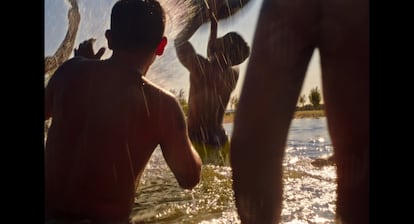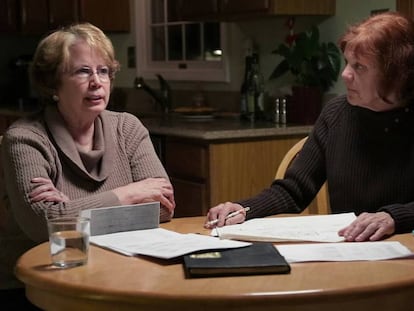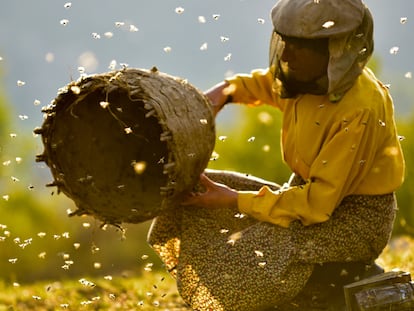A group of friends divided by jail open up in film
The documentary ‘La mala familia’ delves into the reality of a gang who face the mistakes of their past, changing their outlook on life in the process


Short sentences have a cost. A large part of the veteran prisoners segregates the new inmate, whom the officials also inherently distrust. The newcomer becomes the focus of intense scrutiny: why does he have trouble sleeping? Is there a reason to keep his cell so clean and tidy? Did he skip dessert at lunch, again? Meanwhile, long-term inmates pull rank and are not subjected to this kind of inspection. At least this is what Andrés P. Gómez, 28, concluded after his time at the Villabona Penitentiary Center in Asturias, Spain, where he was locked up for three months. By then, he was already preparing a documentary about the deep mark that prison had left on him and his group of friends. The result is titled La mala familia (The bad family), directed by Nacho A. Villar and Luis Rojo.
The film, which will be available on Netflix in a few months, is an urgent documentary about six working-class boys who face the legal consequences of a brawl. One night of alcohol and testosterone in the center of Madrid, things turned ugly. Six years later they all face prison terms, although initially only Gómez will serve time; the incarceration of the others depends on them paying a fine of €330 (about $360) a month for two years. Failure to pay, even once, would put their freedom at risk. Doubt undermines their friendship. Narrated from a place of absolute honesty, the film opens with Gómez pleading guilty before the judge, full of regret. Today he has rebuilt his life and works as a delivery person. “I accept my sentence, but if I feel freed it is not because of jail, but because of the movie,” he says.

Gómez was arrested in Asturias, still wearing his work overalls; he barely had time to notify his sentimental partner. “The episode had occurred when I was 18. When I was thrown into jail I was already more organized, more focused. It was a blow. Until then I had been deceiving myself, telling me that the day would never come,” he relates. He served a sentence in the Therapeutic and Educational Unit of the Villabona prison, where receiving visits and sending letters are limited to two or three people per inmate. The toilets in the unit can only be used for 10 minutes; after that time, the person in charge usually goes to take a look, in order to avoid drug use. The time limits and the enormous weight of the routine pierced Gómez’s chest. “I was so overwhelmed that I thought about ending it all,” he confesses. Until he was released with parole, largely thanks to the documentary.
The directors had worked hard to defend the social nature of the project, which redeemed its protagonists. “That was the support that we could offer him from our privilege,” says Villar. “It must be noted that it was an exception; most of the prisoners with sentences of less than one year have to stick it out.” The shooting crew set up shop two weeks before Gómez’s first leave in a marsh on the outskirts of Madrid. The idea was to bring together the entire Bad Family, as they call themselves since their teenage years, when they met at urban music concerts, squares south of the city and skate parks. Rojo points out: “This story was best told in the field, without towers or graffiti to camouflage the character. The neighborhood is not a set; it’s something you carry with you.”
“We wanted them to get out of the pressure zones, their everyday zones, to connect with their emotions,” adds the filmmaker. A total of 19 young people camped there, including the defendants, all waiting for Gómez’s visit. The camera witnessed conversations and hugs without intervening in any way. However, there was a script with some topics that had been agreed upon in advance; the matter of the consequences of not paying the fine, for instance, was crucial to round off production. None of those involved was fully aware of the situation of the others, perhaps out of anger or shame. The issue came up for the first time during a sequence shot that oozes truth. Some of them were close to giving up. The fine they have to pay is higher than their rent. Others refuse to end up in jail, and will bear the weight on behalf of others.

At this point, it could be said that the film shapes the reality. “We were no longer faced with the simple documentation of the facts with which we started the movie; it was not fiction, either. Everything happened spontaneously,” states Rojo. Behind the tact of the images is his sensitive view of a reality that lends itself to clichés. That is the trademark of the Brbr collective, of which both directors are part, rooted in Madrid’s underground scene. They are also responsible for some of C. Tangana’s videos, although they devote most of their time to advertising communication. For their first feature film they bet on a raw portrait of alienation, loss, power and friendship. A friendship that also binds them to Gómez, who had already worked with them as an actor. “The film is only a very small part of the journey we have taken together. The change in the collective dynamic is evident, now they talk about things, they are more transparent among themselves,” Villar concludes.
The best proof that the project transcends the screen is called Yamel, another of the affected. Throughout the film, he expresses his fear of going to jail; today, as in a self-fulfilling prophecy, he is in prison for causes unrelated to the fight. Visiting him and writing him often are two resolutions of the group, which otherwise has not suffered any more casualties and is at peace with the law. Celebrating a year of freedom, Gómez closes his eyelids tightly and confesses: “I want to let my guard down, share my problems so they don’t weigh me down. I had to hit bottom to get well. When I was little, things could have been explained to me in a different way, without accumulating so much hatred, which distances you from people. Now I’m happy to help out a friend, to offer my little tricks to move forward, as other fuckers did with me.” In the process, he has gotten rid of his ghosts, and the Bad Family is closer than ever.
Sign up for our weekly newsletter to get more English-language news coverage from EL PAÍS USA Edition
Tu suscripción se está usando en otro dispositivo
¿Quieres añadir otro usuario a tu suscripción?
Si continúas leyendo en este dispositivo, no se podrá leer en el otro.
FlechaTu suscripción se está usando en otro dispositivo y solo puedes acceder a EL PAÍS desde un dispositivo a la vez.
Si quieres compartir tu cuenta, cambia tu suscripción a la modalidad Premium, así podrás añadir otro usuario. Cada uno accederá con su propia cuenta de email, lo que os permitirá personalizar vuestra experiencia en EL PAÍS.
¿Tienes una suscripción de empresa? Accede aquí para contratar más cuentas.
En el caso de no saber quién está usando tu cuenta, te recomendamos cambiar tu contraseña aquí.
Si decides continuar compartiendo tu cuenta, este mensaje se mostrará en tu dispositivo y en el de la otra persona que está usando tu cuenta de forma indefinida, afectando a tu experiencia de lectura. Puedes consultar aquí los términos y condiciones de la suscripción digital.
More information
Archived In
Últimas noticias
Trump claims peace in Ukraine is near, but Moscow suggests otherwise
A survivor’s account of the Interoceanic Train accident: ‘We were scared because of the speed on the curve’
The Interoceanic Train, the Mexican alternative to the Panama Canal
What is known about the Interoceanic Train derailment in Oaxaca
Most viewed
- Oona Chaplin: ‘I told James Cameron that I was living in a treehouse and starting a permaculture project with a friend’
- Reinhard Genzel, Nobel laureate in physics: ‘One-minute videos will never give you the truth’
- Why the price of coffee has skyrocketed: from Brazilian plantations to specialty coffee houses
- Pablo Escobar’s hippos: A serious environmental problem, 40 years on
- Chevy Chase, the beloved comedian who was a monster off camera: ‘Not everyone hated him, just the people who’ve worked with him’










































